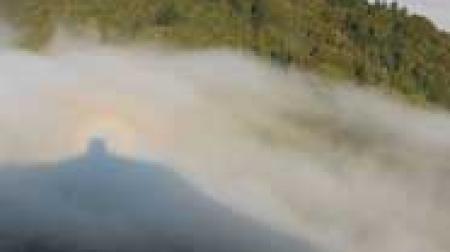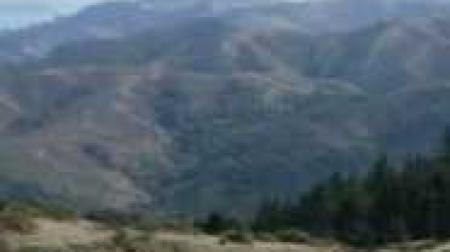Why Was This Indicator Chosen?
Maritime chaparral, which is associated with several special-status species, is found on Mt. Tam’s marine-influenced lower elevations. Over half of the 95 species and subspecies of manzanita in California are locally endemic, occurring in lowlands adjacent to the coast and within the summer marine fog zone (Vasey & Parker, 2014). As a result of this diversity, maritime chaparral communities are recognized as one of the most diverse woody communities in the state (Sawyer et al., 2009).
Maritime chaparral plant species of special interest in the One Tam area of focus include:
- The rare Marin manzanita (Arctostaphylos virgata) CNPS rank 1B.2: Plants Rare, Threatened, or Endangered in California and Elsewhere - Moderately threatened in California
- Coinleaf manzanita (Arctostaphylos sensitiva) a regional endemic on Mt. Tam, and a good indicator of maritime chaparral health
- Mason’s ceanothus (Ceanothus masonii) CNPS rank 1B.2: Plants Rare, Threatened, or Endangered in California and Elsewhere - Moderately threatened in California
- Point Reyes ceanothus (C. gloriosus var. exaltatus) CNPS rank 4.3 Plants of Limited Distribution - A Watch List - Not very threatened in California
What is Healthy?
The desired condition is to maintain viable populations of maritime chaparral community endemics over a minimum of 90 acres of endemic habitat.
What Are the Biggest Threats?
- Removal of fire as a key ecosystem process, resulting in vegetation succession from chaparral to forests, and a loss of the periodic fires necessary for chaparral regeneration
- Douglas-fir (Pseudotsuga menziesii) encroachment due to a lack of fire and the resulting impacts on shade-intolerant scrub and chaparral species
- Impacts from road and trail maintenance such as introduced plant pathogens, or vegetation clearing
- Threats to shallow-rooted and/or fog-dependent maritime chaparral species from drought and changes to fog patterns as a result of climate change
- Plant diseases such as the fungal pathogen Phytophthora ramorum, which causes Sudden Oak Death, and P. cinnamomi, which is particularly deadly to some manzanitas
What is The Current Condition?
The overall condition of Mt. Tam’s maritime chaparral is Poor. No significant changes in the metrics used for this indicator have been detected since 2016. The number of individual plants and age classes of Mason’s ceanothus, Point Reyes ceanothus, and Marin manzanita are in Poor condition, although the overall extent of rare species is good.
What is the Current Trend?
Overall, maritime chaparral is Declining. The number of individual plants and age classes of Mason’s ceanothus, Marin manzanita, and Point Reyes ceanothus are declining, though there has been no discernible trend in the extent of rare species.
How Sure Are We?
We have Moderate confidence in this assessment. National Park Service staff conducted surveys to monitor rare chaparral endemics in 2017 and 2020, but these surveys did not encompass all known populations. Consequently, we have a lower confidence in our current condition and trend assessment than we did in 2016.
What is This Assessment Based On?
Note that we currently only have information from Bolinas Ridge proper, which is based on the following:
- National Park Service Rare_Plant_Population.gdb. Golden Gate National Recreation Area, GIS data (updated 2022)
- Marin Water rare plant maps and surveys (1990, 2009, 2012, and 2015)
- California Natural Diversity Database data for the One Tam area of focus (downloaded January 2016) (California Department of Fish and Wildlife, 2009)
What Don’t We Know?
Key information gaps include:
- A genetic analysis of Mason’s ceanothus to determine if it is a viable species, or a series of semi stable or introgressing hybrids between C. gloriosus var. exaltatus and C. cuneatus var. ramulosus
- Research on germination requirements and seed life for rare species to determine if maritime chaparral that has been taken over by forest can return to chaparral after a fire
- A field study is needed to determine the presence, impacts, and spatial extent of plant pathogens
resources
Aerial Information Systems [AIS]. (2015). Summary report for the 2014 photo interpretation and floristic reclassification of Mt. Tamalpais watershed forest and woodlands project. Prepared for Marin Municipal Water District.
California Department of Fish and Wildlife [CDFW]. (2009). California natural diversity database. Downloaded January 2016 from https://www.wildlife.ca.gov/Data/CNDDB
California Native Plant Society, Rare Plant Program [CNPS]. (2022). Rare plant inventory (Version 9.5) [Website]. Retrieved December 30, 2022 from https://www.rareplants.cnps.org
California Oak Mortality Task Force. (2015). California oak mortality task force report.https://tinyurl.com/mps3ne55
Golden Gate National Parks Conservancy [GGNPC], Tukman Geospatial, & Aerial Information Systems. (2021). 2018 Marin County fine scale vegetation map datasheet. Tamalpais Lands Collaborative (One Tam). https://tukmangeospatial.egnyte.com/dl/uQhGjac1zw
Johnstone, J. A., & Dawson, T. E. (2010). Climatic context and ecological implications of summer fog decline in the coast redwood region. Proceedings of the National Academy of Sciences, 107(10), 4533–4538. https://doi.org/10.1073/pnas.0915062107
Kauffmann, M., Parker, T., & Vasey, M. (2015). Field guide to manzanitas: California, North America, and Mexico. Backcountry Press.
Keeley, J. E. (2007). Chaparral and fire. Fremontia, 35(4), 16–21. https://cnps.org/wp-content/uploads/2018/03/Fremontia_Vol35-No4.pdf
Leonard Charles Associates. (2009). Biodiversity management plan for Marin Municipal Water District Lands [Unpublished].
O’Neill, S., & Williams, A. (2006). Rare plant species monitoring protocol for San Francisco Bay Area network [Unpublished].
Paddock, W. A. S., III, Davis, S. D., Pratt, R. B., Jacobsen, A. L., Tobin, M. F., López-Portillo, J., & Ewers, F. W. (2013). Factors determining mortality of adult chaparral shrubs in an extreme drought year in California. Aliso, 31(1), 49–57. https://scholarship.claremont.edu/aliso/vol31/iss1/8
Patterson, C. A. (1990). Sensitive plant survey of the Marin Municipal Water District, Marin County, California.
Sawyer, J. O., Keeler-Wolf, T., & Evens, J. (2009). Manual of California vegetation. California Native Plant Society Press.
Thorne, J. H., Choe, H., Boynton, R. M., Bjorkman, J., Albright, W., Nydick, K., Flint, A. L., Flint, L. E., & Schwartz, M. W. (2017). The impact of climate change uncertainty on California’s vegetation and adaptation management. Ecosphere, 8(12), e02021. https://doi.org/10.1002/ecs2.2021
Vasey, M. C., & Parker, V. T. (2014). Drivers of diversity in evergreen woody plant lineages experiencing canopy fire regimes in Mediterranean-type climate regions. In N. Rajakaruna, R. S. Boyd, & T. B. Harris (Eds.), Plant ecology and evolution in harsh environments (pp. 179–200). Nova Publishers. https://tinyurl.com/2p9hhh77
Vasey, M. C., Parker, V. T., Holl, K. D., Loik, M. E., & Hiatt, S. (2014). Maritime climate influence on chaparral composition and diversity in the coast range of central California. Ecology and Evolution, 4(18), 3662–3674. https://doi.org/10.1002/ece3.1211
Werner, Z., Hin Choi, C. T., Winter, A., Vorster, A. G., Berger, A., O’Shea, K., Evangelista, P., & Woodward, B. (2022). MODIS sensors can monitor spatiotemporal trends in fog and low cloud cover at 1 km spatial resolution along the U.S. Pacific Coast. Remote Sensing Applications: Society and Environment, 28, 100832. https://doi.org/10.1016/j.rsase.2022.100832




